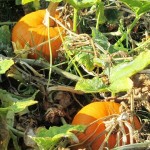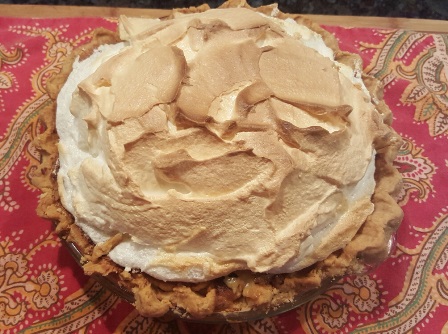The Quiet Beauty of a Winter Garden
There is a quiet beauty in a winter garden. You must endure cold to appreciate it. On my farmette, there’s also fog and wind and misty rain. But as you gaze in mindfulness, the rewards come.
When trees are bare, you can appreciate the beauty of their scaffolding, branching habits, and fruiting spurs. There is an attractiveness about tree bark that is rough or smooth and colored in earthy hues of green, gray, or reddish brown. Bare trunks and branches provide visual interest until blossoms and blooms break in spring.
With pruning done and leaves removed, the roses rest. Birds gather at feeders and frolic in the fountains. Beneath the soft, damp earth, roots are taking in nutrients to prepare the fruit trees for a surge of growth when warmer days arrive.
The garden is a place to conjure memories and ponder life and destiny. Goethe, the German playwright, poet, and novelist wrote that “Sometimes our fate resembles a fruit tree in winter. Who would think that those branches would turn green again and blossom, but we hope it, we know it.”
Winter is the perfect time to contemplate the tap root of your being and to think and and dream and plan for what will blossom in your life when warmth and light returns. French philosopher and author Alfred Camus wrote, “In the depths of winter, I finally learned that within me there lay an invincible summer.”
I have a simple ritual of visiting my winter garden. I prepare a cup of hot water with juice of half a lemon and a tablespoon of honey or sometimes just a cup of coffee or tea. Then with cup in hand, off I go to inspect the fruit trees, the bare grape and berry vines, and the soil turned in raised boxes waiting to receive kitchen herbs. This ritual inspires me and silently powers me up with hope and energy.
Perhaps you have a similar winter ritual. If not, consider checking out my newest nonfiction book, RITUALS FOR LIFE and plant something in the earth or the garden of your psyche that holds the promise of bearing fruit in its own perfect time. Now is the time to greet each new winter day for the blessings it brings and appreciate the stark beauty of Nature.

More than 150 rituals for sound mind, strong body, and meaningful connections to the people around you
Add a Secret Ingredient to Kick-start Your Compost Pile
The leaves of my plum and cherry trees are beginning to drop. The fig leaves have dried to a crisp and are also falling. I’ve got pumpkin and squash vines and stalks of corn pulled and lying in piles in the garden.
This dead, particulate organic matter (detritus) in my garden is too good to throw in the green recycle bin for the city to compost. By composting it myself, I’ll save the money I might spend on buying compost next year.
If your garden has a pile or two of of similar detritus but you’ve had trouble getting it to break down into compost, you might be missing a secret ingredient.
Add one to two cups of a nitrogen-rich garden product like blood meal, bone meal, or cottonseed meal–all are available from your local nursery or garden center.
Follow these simple steps.
1. Dump a wheelbarrow load of leaves where you will be composting this fall and winter. I use a rectangular raised bed.
2. From a cup of blood meal, generously sprinkle the meal onto the leaves.
3. Layer onto the pile grass clippings, pumpkin and squash vines, corn cobs, chicken house straw, dried oats, weeds, and other biomass material.
4. Add more blood meal, more leaves, and more organic material.
5. Sprinkle the remaining blood meal from your cup onto the compost pile and then wet it using a garden hose.
6. Cover with plastic sheeting.
The compost pile generates heat as the plant material breaks down. Thoroughly turn at two or three week intervals. Keep the pile moist (not drenched) and covered.
Using this method, you can expect to have lovely nutrient-rich compost to use on your spring flower and vegetable gardens.
___________________________________________________________________
If you enjoy reading about gardening topics and you are a mystery lover, check out my Henny Penny Farmette series of mysteries from Kensington Publishing. Each charming novel features a wholesome whodunnit along with delicious recipes and farming facts and tips.
Click here to see more: http://tinyurl.com/ya5vhhpm
Join me for “Coffee and Conversation” at Towne Center Books in Pleasanton, The date is Wednesday, October 18, 2017, at 11:00 a.m. The address is: 555 Main Street, Pleasanton, California. Phone is (925) 846-8826.
I’ll be sharing information about my farmette, my mystery-writing process, and my newest novel, A HIVE OF HOMICIDES.
Winter Solstice Day
It’s that time of the year when we mark the shortest day of the year, the beginning of winter, and the return of the light. I like to think of it as a day when I decide what I do and don’t want to take with me into the coming New Year.
We’ve had a run of cold nights with temperatures in the upper 20 degrees Fahrenheit. But the light will soon return and warm the Earth. Late January-early February marks the beginning of bare-root season. My work now includes pruning and spraying and clearing out the old to make way for rebirth and renewal.
Among the plants that renew are the fruit trees. The pruned branches, garden clippings, and old vines are being recycled into compost for next spring’s garden. Come late spring, I’ll have trees with gorgeous canopies and tons of fruit to make into jam.

This DIY birdhouse is crafted from a repurposed fence board. Not all birds will take up residence in a house, but many will.
Garlic and onions are growing now and will through the winter months, thanks to our mild Mediterranean climate. But there is so much cleanup of the property that needs doing, I can only hope to start that today.
I’m putting out seed balls for the birds as well as refilling feeders and suet holders. Easy-to-find food keeps our feathered songsters around through spring when they start their families. For directions on making a birdhouse for your garden, check out https://hobbyreads.wordpress.com/category/crafts.
*******************************************************************************************************************************************************
Enjoy reading about farming topics? Check out my cozy mysteries–A BEELINE TO MURDER and also THE MURDER OF A QUEEN BEE (both in the Henny Penny Farmette series from Kensington Publishing).
JOIN THE CHRISTMAS EVE FUN–Read a short excerpt from my newest book, THE MURDER OF A QUEEN BEE and check out blogger Brooke Bumgardner’s interview of me at http://www.brookeblogs.com
My farmette and bee-based novels are chocked full of recipes, farming tips, chicken and beekeeping tips, sayings and, of course, a charming cozy mystery. For more info, click on the links under the pictures.
The books are available through online retailers such as Amazon, Barnes & Noble, Target, BAM, Kobo Books, and Walmart as well as from traditional bookstores everywhere.
See, http://tinyurl.com/hxy3s8q
This debut novel launched the Henny Penny Farmette series of mysteries and sold out its first press run. It’s now available in mass market paperback and other formats.
See, http://tinyurl.com/h4kou4g
NEWLY RELEASED! This, the second cozy mystery in the Henny Penny Farmette series, is garnering great reviews from readers and industry publications. Get your copy while you can. It’s sure to sell out like novel #1.
Great Pie Begins with a Buttery, Flaky Crust
My stalwart Scots-Irish grandmother was thrifty and talented when it came to food preparation. She made delicious pies from cherry, rhubarb, peaches, apples, pears, and sweet berries of every kind, including gooseberries. Her pies were my childhood delight when I lived with her and my grandfather on their Boone County, Missouri farm.
She made delicious meat pies from meats she’d preserved by canning. Missouri winters could be harsh. Those meat pies nourished me when the snow piled up outside the windows, and it was too cold to make a trek to the smoke house where her prized Boone County hams hung from hooks.
Sometimes, my grandmother combined fruits or berries in a rustic pie (today, we call it a galette) and on other occasions, she made a raisin, pecan, pumpkin, coconut, or a custard pie. And meringue, if used, was high and sweet and just the right shade of golden brown. But it was the pie crust that I loved.
For the top of a peach pie, she’d cut in a large curve shaped like a branch. Then two or three other lines would curve from it. Lastly, she cut teardrop shapes along the arch lines so the top crust art would suggest a peach tree branch. When she worked crisscross strips atop a cherry pie, it was both beautiful and delicious.
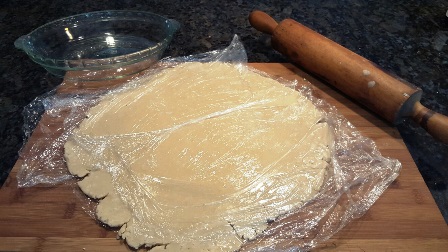
Storing or rolling the crust between sheets of plastic wraps is a good way to avoid handling the crust with your hands.
The secret to her buttery, flaky crust was not to handle it too much. Today, I make the same recipe but in my food processor. Like her, I use chilled or ice water, adding only drops at at time as the food processor is pulsing the dough–only enough to get the dough clinging together. The point is to move the dough from dry and crumbly to clumping into a ball.
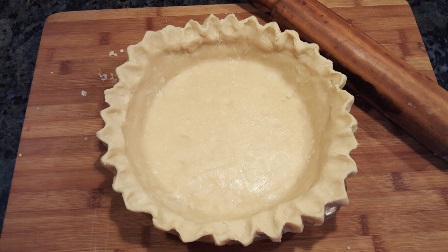
This fluted crust is ready for almost any kind of filling. I will prick the bottom and sides with a fork before filling and baking.
After the dough is made, I dump it from the food processor bowl onto aluminum foil or plastic wrap and work it into a ball (without touching it). The dough goes into the fridge for a chill over an hour and up to 24 hours. The recipe makes enough for a pie top and bottom or a couple of pies requiring only the bottom crust.
Ingredients:
2 1/2 cups flour
1/2 teaspoon salt
1 teaspoon granulated sugar
1 cup chilled unsalted butter, cut into pieces
1/4 (plus a few tablespoons more if necessary) cold or ice water
Directions:
Add the dry ingredients (flour, salt, and sugar) in the food processor bowl.
Cut the butter into small chunks and drop the pieces in. Pulse into a crumbly, dry meal.
Add ice water to the mixture in the bowl by dropping spoonfuls through the feeding tube and pulsing after each addition.
Remove the dough when it clings together–neither too wet nor too dry–by dumping it out on a large sheet of aluminum foil or plastic wrap.
Mold the dough into a ball and flatten into a thick disk to make it easier to roll out.
Chill for an hour or up to 24 hours.
Makes two buttery, flaky crusts.
* * *
If you enjoy reading about farmette topics (including gardening, beekeeping, and delicious recipes), check out my cozy mysteries A BEELINE TO MURDER and also THE MURDER OF A QUEEN BEE in the Henny Penny Farmette series (from Kensington Publishing).
These novels are available through online retailers such as Amazon, Barnes & Noble, Kobo Books, and Walmart as well as from traditional bookstores everywhere.
See, http://tinyurl.com/hxy3s8q
Now available in mass market paperback, this debut novel launched the Henny Penny Farmette series of mysteries and sold out its first press run.
See, http://tinyurl.com/h4kou4g
The second cozy mystery in the Henny Penny Farmette series, available Sept. 27, 2016, is now available on Net Galley (netgalley.com) for professionals and readers who write reviews.
Attracting Mourning Doves to Your Backyard
Despite its drab brown coloring with pink legs and round eyes, the Mourning Dove (also known as the Turtle Dove, Rain Dove, and the Carolina Turtledove) is one of the most easily recognized backyard birds in America.
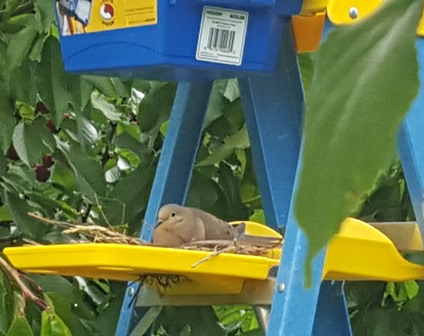
The ladder is a tall one for picking cherries, but it works as a platform for a nest constructed by a pair of Mourning Doves
We welcome them to the farmette with the lure of seeds, the type of food that makes up most of their diet. My hubby and I place seeds in low-hanging feeders or on the stone retaining wall. Sometimes, we even cast birdseed near the outer edge of the garden.
These birds also need a source of water. Because we keep chickens and bees, we have fountains running year-round. With an ample supply of food and water and plenty of fruit trees, tall grass, bamboo, and berry bushes for habitat, it’s no wonder the doves and other birds hang around here to mate in spring.
What surprises me is that one Mourning Dove couple has made a nest on top of the ladder I left out while picking some ripe cherries. The nest didn’t look too substantial, but I guess it works for them. I climbed up on a chair nearby to see the two white eggs after the dove left the nest. Within seconds, she dive bombed me and I nearly fell off the chair.
Mourning doves usually lay two eggs that are incubated by both parents, taking turns. In one spring season, they can repeat the process up to six times. This accounts for their population numbers staying strong in the face of being hunted for sport by humans and stalked as prey by other species. The baby doves are called squabs.
I love the lamenting call of these birds, often at sunset. I also appreciate that they are believed to mate for life. The squabs feed on crop milk–regurgitated secretions from the lining of the crop of the parents.
Attracting these doves into your backyard is easy if you put out a feeder and some seeds. For the July-August issue of GRAND online magazine, I’ve created a birdseed hanging saucer with directions so anyone can make it. Ours has attracted several doves who forage for food morning and evening.
* * *
If you enjoy reading about farmette life, check out my mystery novel series from Kensington Publishing, New York. The books feature a farmette milieu, farm sayings, tips, and facts about animals and bees as well as delicious recipes to try. The books are available from online sources such as Amazon, Barnes & Noble, Walmart and others as well as traditional bookstores everywhere.
BEELINE TO MURDER is the first book in Meera Lester’s Henny Penny Farmette series of mysteries.
Novel #2 in the Henny Penny Farmette series, available Oct. 1, 2016
 Facebook
Facebook Goodreads
Goodreads LinkedIn
LinkedIn Meera Lester
Meera Lester Twitter
Twitter





